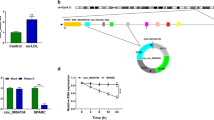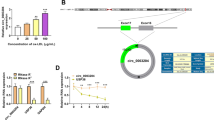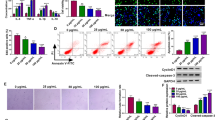Abstract
Oxidized low-density lipoprotein (ox-LDL) modulates gene transcription and expression and induces the development of endothelium inflammation and endothelial dysfunction, in which microRNAs (miRNAs) play a crucial role. However, the mechanism of ox-LDL in inflammatory damage of endothelial cells still remains elusive. Herein, we focused on the effect of hsa-miR-217-5p (miR-217) on endothelial dysfunction induced by ox-LDL by targeting early growth response protein-1 (EGR1). In the present study, 31 upregulated miRNAs and 59 downregulated miRNAs (Fold Change > 2, P value < 0.05) were identified after 6 h of 80 μg/mL ox-LDL exposure in human aortic endothelial cells (HAECs) by small RNA sequencing, including miR-217 that was significantly decreased (FC = 0.2787, P value = 5.22E-16). MiR-217 knockdown inhibited cell proliferation and increased level of IL-6, IL-1β, ICAM-1 and TNF-α, while overexpression of miR-217 relieved the growth inhibition induced by ox-LDL and demonstrated anti-inflammatory effect in HAECs. EGR1 was predicted as a potential candidate target gene of miR-217 by TargetScan. The subsequent dual-luciferase reporter assay confirmed the direct binding of miR-217 to 3′UTR of EGR1. And EGR1 expression was negatively correlated with the level of miRNA-217 in HAECs after exposure to ox-LDL. Overexpression of EGR1 recapitulated the effects of miR-217 knockdown on cell proliferation inhibition and inflammation in HAECs, while knockdown EGR1 relieved the proliferative inhibition and demonstrated anti-inflammatory effect in ox-LDL-induced HAECs. The present study confirmed miR-217 ameliorates inflammatory damage of endothelial cells induced by oxidized LDL by targeting EGR1.


modified by exogenous change in miR-217 in HAECs. *P < 0.05, **P < 0.01 vs miRNA-NC. d Relative mRNA expression (qRT-PCR) of IL-6, IL-1β, ICAM-1 and TNF-α was increased after ox-LDL exposure. **P < 0.01 vs untreated HAECs. e Relative mRNA expression (qRT-PCR) of IL-6, IL-1β, ICAM-1 and TNF-α after exogenous change in miR-217 in HAECs was determined by qRT-PCR. *P < 0.05, **P < 0.01 vs miRNA-NC. f Levels of IL-6, IL-1β, ICAM-1 and TNF-α in supernatant (ELISA) were increased after ox-LDL exposure. *P < 0.05, **P < 0.01 vs untreated HAECs. g Levels of IL-6, IL-1β, ICAM-1 and TNF-α in supernatant after exogenous change in miR-217 were determined by ELISA. *P < 0.05, **P < 0.01 vs miRNA-NC. n = 3



Similar content being viewed by others
References
Harja E, Bucciarelli LG, Lu Y, Stern DM, Zou YS, Schmidt AM, Yan SF (2004) Early growth response-1 promotes atherogenesis: mice deficient in early growth response-1 and apolipoprotein E display decreased atherosclerosis and vascular inflammation. Circ Res 94(3):333–339. https://doi.org/10.1161/01.RES.0000112405.61577.95
Lin F, Pei L, Zhang Q, Han W, Jiang S, Lin Y, Dong B, Cui L, Li M (2018) Ox-LDL induces endothelial cell apoptosis and macrophage migration by regulating caveolin-1 phosphorylation. J Cell Physiol 233(10):6683–6692. https://doi.org/10.1002/jcp.26468
Liu KL, Yang YC, Yao HT, Chia TW, Lu CY, Li CC, Tsai HJ, Lii CK, Chen HW (2016) Docosahexaenoic acid inhibits inflammation via free fatty acid receptor FFA4, disruption of TAB2 interaction with TAK1/TAB1 and downregulation of ERK-dependent EGR1 expression in EA.hy926 cells. Mol Nutr Food Res 60(2):430–443. https://doi.org/10.1002/mnfr.201500178
Yan SF, Harja E, Andrassy M, Fujita T, Schmidt AM (2006) Protein kinase C beta/early growth response-1 pathway: a key player in ischemia, atherosclerosis, and restenosis. J Am Coll Cardiol 48(9 Suppl 1):A47–55. https://doi.org/10.1016/j.jacc.2006.05.063
Pagel JI, Ziegelhoeffer T, Heil M, Fischer S, Fernández B, Schaper W, Preissner KT, Deindl E (2012) Role of early growth response 1 in arteriogenesis: impact on vascular cell proliferation and leukocyte recruitment in vivo. Thromb Haemost 107(3):562–574. https://doi.org/10.1160/TH11-07-0490
Virolle T, Adamson ED, Baron V, Birle D, Mercola D, Mustelin T, de Belle I (2001) The EGR1 transcription factor directly activates PTEN during irradiation-induced signalling. Nat Cell Biol 3(12):1124–1128. https://doi.org/10.1038/ncb1201-1124
Davies PF, Civelek M, Fang Y, Fleming I (2013) The atherosusceptible endothelium: endothelial phenotypes in complex haemodynamic shear stress regions in vivo. Cardiovasc Res 99(2):315–327. https://doi.org/10.1093/cvr/cvt101
Guo H, Ingolia NT, Weissman JS, Bartel DP (2010) Mammalian microRNAs predominantly act to decrease target mRNA levels. Nature 466(7308):835–840. https://doi.org/10.1038/nature09267
Zhang X, Wang Z, Li W, Huang R, Zheng D, Bi G (2020) MicroRNA-217-5p ameliorates endothelial cell apoptosis induced by ox-LDL by targeting CLIC4. Nutr Metab Cardiovasc Dis 30(3):523–533. https://doi.org/10.1016/j.numecd.2019.09.027
Jiang YH, Jiang LY, Wang YC, Ma DF, Li X (2020) Quercetin attenuates atherosclerosis via modulating oxidized LDL-induced endothelial cellular senescence. Front Pharmacol 11:512. https://doi.org/10.3389/fphar.2020.00512
Jiang YH, Li X, Niu W, Wang D, Wu B, Yang CH (2020) β-sitosterol regulated microRNAs in endothelial cells against oxidized low-density lipoprotein. Food Funct 11(2):1881–1890. https://doi.org/10.1039/c9fo01976f
Langmead B, Trapnell C, Pop M, Salzberg SL (2009) Ultrafast and memory-efficient alignment of short DNA sequences to the human genome. Genome Biol 10(3):R25. https://doi.org/10.1186/gb-2009-10-3-r25
Zhou Y, Gao C, Wang H, Liu L, Huang Z, Fa X (2018) Histamine H1 type receptor antagonist loratadine ameliorates oxidized LDL induced endothelial dysfunction. Biomed Pharmacother 106:1448–1453. https://doi.org/10.1016/j.biopha.2018.07.025
Menghini R, Casagrande V, Cardellini M, Martelli E, Terrinoni A, Amati F, Vasanicotera M, Ippoliti A, Novelli G, Melino G (2009) MicroRNA 217 modulates endothelial cell senescence via silent information regulator 1. Circulation 120(15):1524–1532. https://doi.org/10.1161/CIRCULATIONAHA.109.864629
Duan H, Li Y, Yan L, Yang H, Wu J, Qian P, Li B, Wang S (2016) MicroRNA-217 suppresses homocysteine-induced proliferation and migration of vascular smooth muscle cells via N-methyl-D-aspartic acid receptor inhibition. Clin Exp Pharmacol Physiol 43(10):967–975. https://doi.org/10.1111/1440-1681.12611
Liu H, Li X, Song Y, Wang Z (2018) MicroRNA-217 attenuates intima-media complex thickness of ascending aorta measured by ultrasound bio-microscopy and inhibits inflammation and lipid metabolism in atherosclerotic models of ApoE-/- mice. Lipids Health Dis 17(1):170. https://doi.org/10.1186/s12944-018-0825-2
Yao J, Mackman N, Edgington TS, Fan ST (1997) Lipopolysaccharide induction of the tumor necrosis factor-alpha promoter in human monocytic cells. Regulation by EGR1, c-Jun, and NF-kappaB transcription factors. J Biol Chem 272(28):17795–17801. https://doi.org/10.1074/jbc.272.28.17795
McCaffrey TA, Fu C, Du B, Eksinar S, Kent KC, Bush H Jr, Kreiger K, Rosengart T, Cybulsky MI, Silverman ES, Collins T (2000) High-level expression of EGR1 and EGR1-inducible genes in mouse and human atherosclerosis. J Clin Invest 105(5):653–662. https://doi.org/10.1172/JCI8592
Yu X, Shen N, Zhang ML, Pan FY, Wang C, Jia WP, Liu C, Gao Q, Gao X, Xue B, Li CJ (2011) EGR1 decreases adipocyte insulin sensitivity by tilting PI3K/Akt and MAPK signal balance in mice. EMBO J 30(18):3754–3765. https://doi.org/10.1038/emboj.2011.277
Yuan S, Wen J, Cheng J, Shen W, Zhou S, Yan W, Shen L, Luo A, Wang S (2016) Age -associated up-regulation of EGR1 promotes granulosa cell apoptosis during follicle atresia in mice through the NF-κB pathway. Cell Cycle 15(21):2895–2905. https://doi.org/10.1080/15384101.2016.1208873
Wang S, Liang C, Ai H, Yang M, Yi J, Liu L, Song Z, Bao Y, Li Y, Sun L, Zhao H (2019) Hepatic miR-181b-5p contributes to glycogen synthesis through targeting EGR1. Dig Dis Sci 64(6):1548–1559. https://doi.org/10.1007/s10620-018-5442-4
Acknowledgements
We thank Ms Qian Zhou of Shanghai Genomeditech Corporation for technical assistance.
Funding
This study was supported by the National Natural Science Foundation of China No. 81673807 and ‘Taishan Scholar’ Project of Shandong Province No. 2018-35.
Author information
Authors and Affiliations
Contributions
YXS performed the experiments and drafted the manuscript. LDN contributed small RNA sequencing and transfection. QYZ participated in the data interpretation and discussion. CWJ contributed to software applications and data analysis. YCH and JYH designed the study and carried out important revisions of the manuscript. All authors read and approved the final manuscript.
Corresponding authors
Ethics declarations
Conflict of interest
The authors declare that they have no conflict of interest.
Additional information
Publisher's Note
Springer Nature remains neutral with regard to jurisdictional claims in published maps and institutional affiliations.
Rights and permissions
About this article
Cite this article
Yang, X., Li, D., Qi, YZ. et al. MicroRNA-217 ameliorates inflammatory damage of endothelial cells induced by oxidized LDL by targeting EGR1. Mol Cell Biochem 475, 41–51 (2020). https://doi.org/10.1007/s11010-020-03857-w
Received:
Accepted:
Published:
Issue Date:
DOI: https://doi.org/10.1007/s11010-020-03857-w




